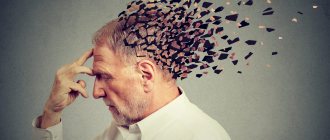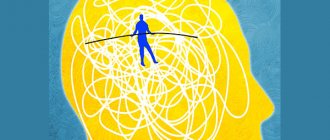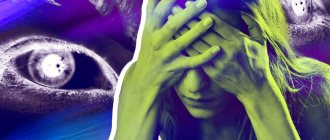In the scientific community, schizophrenia refers to a complex personality disorder at the psychological level, leading to disturbances in emotional reflexes and mental abilities. According to official statistics, 1% of people suffer from this disease, not counting those who are not aware of the problem. Treatment of schizophrenia is aimed at relieving acute symptoms, which gives the person a chance to return to normal life. But most people treat such patients with prejudice and negativity, which has given rise to many myths in this direction. They are baseless, but firmly rooted in the consciousness of the people.
Schizophrenics are dangerous to society due to cruelty and aggressiveness
This is also partly a myth. Many people have the impression that people with schizophrenia pose a threat to others. Mostly this is the negative influence of media and films. In fact, people with schizophrenia are as harmless as children. On the contrary, they themselves often become targets of criminal attacks.
A different scenario happens in the absence of proper treatment. Then, in the acute stage of the disease, a person is prone to violence under the influence of visions and delusional thoughts. It’s more scary when there are hallucinations of an auditory nature in the form of a call for specific hostile actions.
For example, in 2015, one resident of Nizhny Novgorod, during an exacerbation of schizophrenia, killed his own family (six children, wife and mother). He explained the action by saying that he heard an order to act in this way. Belov suffered from schizophrenia for a long time and repeatedly showed aggression towards his wife. Relatives tried to keep it a secret and did not seek help from doctors.
No less dangerous are delusional states associated with persecution mania. A person sees everyone and everything around him as a threat to himself. To protect himself, he often begins to defend himself from supposedly attacking people. Therefore, during an exacerbation of schizophrenia, relatives close to the patient are at greater risk.
Incurable disease
Patients with schizophrenia require lifelong maintenance therapy. However, very often the patient does not recognize the disease, so the percentage of patients who consider themselves mentally ill is very small.
“It’s difficult to monitor them, it’s difficult to explain that they need to take medications to prevent an exacerbation. The union between doctor and patient during treatment is compliance. If it is formed, everything is fine: the patient has recognized the disease, he knows the signs of exacerbation, when he needs to seek help from a psychiatrist,” continues Vitaly Voronov.
The patient's lack of awareness that he is sick is called anosognosia. Sometimes doctors have to deal with denial of the disease not only from the patient, but also from his loved ones. This is common even among educated people.
Sergey, 45 years old. Diagnosis: schizophrenia
I take six tablets daily: three antipsychotics, morning, afternoon and evening, and two more to relieve side effects. I will have to take them for life. Twice a year injections. Once or twice a year I go to the dispensary, but there is no exact schedule. When depressing thoughts appear (for example, that I might break a window or jump into a flight of stairs), and I lose sleep, I understand that I need to increase the dosage of the medication, and it is better to do this under the supervision of a doctor.
Most often, mental disorders are detected after emergency hospitalization. In Cherepovets there is a specialized ambulance team No. 17, which consists of psychiatrists. If they diagnose mental pathology, the patient is taken to a dispensary. In less severe conditions, patients can contact their local doctor.
All employees of the psychoneurological dispensary, including janitors and cleaners, do not have the right to take information about patients outside the walls of the hospital.
The psychoneurological dispensary provides three types of care: inpatient, when the patient goes to bed for a course of treatment, day hospital, when the patient visits the dispensary every day, but spends the night at home, and outpatient treatment. Patients in the dispensary need constant supervision by a psychiatrist, drug therapy and monitoring of their condition. For patients who are prone to crime or have committed it in the past, “active follow-up” is used. Such people (there are no more than a hundred of them in Cherepovets) are required to come to the dispensary every month.
4-6 cases per 1000 people - this is the probability of schizophrenia in Russia.
Many physiotherapeutic methods are used to treat neuroses, including electrical stimulation of the brain, phototherapy, electrosleep and massage. In particularly serious cases, when other methods do not help, electroconvulsive therapy is used: an electric current is passed through the brain, causing a “reboot”.
“What we are used to seeing in films about mental hospitals is recognized as inhumane. Now electroconvulsive therapy is used only in exceptional cases when doctors cannot help the patient with medication. As a rule, this is schizophrenia with persistent symptoms, severe depression with suicidal tendencies, when a person is constantly on the verge of suicide. As a rule, memories of the procedure are erased, but there have been cases when patients complained of pain. We are now preparing to launch this procedure in our dispensary. The procedure will be performed under short-term anesthesia; anesthetic equipment has been purchased. All we have to do is get a license,” Vitaly Voronov shares his plans. “This procedure is for very severe forms of the disease, but if they did not occur, we would not even think about such treatment. There are patients who do not respond to medications and are forced to hallucinate, delirium, or become extremely agitated for months. This is dangerous for the life of the patient and others.”
Schizophrenia can develop due to flaws in upbringing
One of the causes of schizophrenia is considered to be improper upbringing. In particular, we are talking about a lack of attention from the mother. In fact, blaming parents in this matter is baseless. No matter how coldly they treat their own child, this cannot provoke illness years later. Schizophrenia is a serious mental disorder, the development of which is caused by a whole complex of negative factors. Here are some of them:
- predisposition at the genetic level;
- head injuries;
- frequent stressful situations;
- brain dysfunction and so on.
There are still many questions in this regard to which scientists have not received accurate answers.
If one of the parents suffers from schizophrenia, the child cannot avoid a similar fate
It is believed that parents with schizophrenia give birth to a mentally ill child. This statement is fundamentally incorrect. Heredity cannot be ruled out, but it is not the disease that is transmitted, but the tendency to it. Therefore, it is wrong to give up on a child whose mother and father or one of them suffers from schizophrenia.
The theoretical probability of inheriting the disease is estimated at 67-88%. But in reality the numbers are not so scary:
- in identical twins (even those with a genetic predisposition) - 45-47%;
- Mom or dad is sick - 14%, both - 45%;
- the diagnosis was made to close relatives – about 5%.
Various types of research continue to establish the degree of inheritance of schizophrenia. But so far the results are mixed and preliminary. Scientists already know specific genes that can trigger the development of the disease. This is revealed by reading genetic information and carefully studying it.
More precise data were obtained by trying to link this disease to changes in the gene component of several candidates. Thus, the majority of schizophrenics have a polyform type of serotonin, dopamine and COMT genes. But their presence can also be associated with other mental disorders. So, even if there is a complete breakdown of the genotype, it is impossible to give an accurate forecast of whether a person will develop schizophrenia or not.
Treatment programs
Treatment of depression
Panic attacks
Treatment of schizophrenia
Neuroses, phobias
Schizophrenia leads to dementia
In life, you can encounter different clinical variants of the development of schizophrenia. Each case is individual. In some, the development of schizophrenia is practically asymptomatic and does not in any way affect mental capabilities. Such patients are still able to think rationally, learn successfully, and do not suffer from memory loss and other manifestations characteristic of schizophrenia.
Other people with a similar diagnosis show obvious deviations at the emotional and mental level. With each new attack, the situation worsens and over time leads to the fact that the person is unable to independently perform basic everyday activities, much less work. There are especially severe forms when the disease progresses rapidly and quickly leads to disability.
No doctor can say for sure what awaits a person with schizophrenia. Despite numerous studies in this direction, science is still powerless. You can compare the state of the brain at different time stages, based on which you can make an approximate forecast.
Cases have been recorded where people suffering from schizophrenia for a long time remain completely adequate and do not lose basic life skills. For example, Nobel laureate D.F. Nash was schizophrenic. But this did not stop him from successfully teaching at the university.
Psychiatrist consultation
24-hour telephone number to contact the doctor on duty: 8 (831) 266-03-06.
Any request for medical help is a medical confidentiality and cannot be disclosed.
Anonymity guaranteed!
Negative psychopathological symptoms in schizophrenia
1. Asthenic phenomena. Asthenia, presented in varying degrees, is most often the result of organic brain damage, somatic diseases, intoxication, depression, prolonged and exhausting overstrain, especially mental and emotional, depleting energy reserves of unresolved internal conflicts, constitution, and taking antipsychotics. Asthenia associated with schizophrenia is relatively rare. Due to some features, I.A. Polishchuk (1956) defined it as vital. Such asthenia occurs without the specific reasons mentioned above.
Patients are focused on the feeling of powerlessness and exhaustion and do not seem to notice other deviations or do not attach serious importance to them; meanwhile, in their mental status, there are no signs of excessive exhaustion: patients can talk for hours without detecting fatigue. Adequate treatment for asthenia and long-term proper rest do not bring the desired effect. Patients often exhibit signs of emotional flattening, decreased empathy, unusual physical sensations, deviations in the sphere of attention and thinking, and disturbances in self-perception. All this allows us to assume that in such cases we are not talking about asthenia itself, but about a loss of awareness of the feeling of vigor, activity and initiative. Of course, under the influence of asthenic factors, patients with schizophrenia may also develop pictures of true asthenia.
Some authors classify the phenomena of asthenia as productive psychopathological disorders (Tiganov, 1999; Bukhanovsky, 2000), others as negative (Polishchuk, 1956; SANS scale). Such contradictions are not isolated, but are more noticeable in relation to deviations in the sphere of elementary sensitivity, thinking and affective syndromes. The latter are not included in the mentioned scale either among productive or negative disorders. The division of disorders into both is relative and rather conditional. Only one thing seems indisputable: productive symptoms do not arise without negative ones, but negative symptoms can exist without productive disorders.
| | Attention! Negative symptoms do not indicate the fact of schizophrenia. Schizophrenia is also necessarily accompanied by productive symptoms, but even if they are present, only a psychiatrist can make a diagnosis after a thorough diagnosis |
2. Signs of mental dissociation or intrapsychic ataxia, manifested by disordered mental functions, their inconsistency in mental functioning. If, for example, a depressed patient with ideas of self-condemnation and feelings of guilt also exhibits delusions of influence or delusions of persecution, then we have the right to record in this case the fact of intrapsychic ataxia.
3. Selective attention - the tendency of patients to ignore dominant, i.e., vitally important stimuli and to react to stimuli that do not have any significant significance. Thus, the patient does not pay attention to the doctor’s questions and at the same time is entirely focused on the play of dust particles on the table.
4. Emotional impoverishment - the fading of emotional reactions to various events and loss of brightness of feelings, which increases with the course of the disease. The ability to empathize also decreases. Complete devastation of the emotional sphere usually does not occur even in long-term ill patients; islands of emotional life are always preserved to one degree or another.
Along with emotional impoverishment, some patients exhibit emotional paradox (the patient shows indifference to serious things, but can react violently to unimportant situations) and emotional duality (the coexistence of polar feelings and affective reactions to the same object or in the same situation; the patient, for example, “loves” his mother and at the same time, as it were, consciously does everything to “drive her to madness”). Parathymia should also be mentioned - the tendency to react to something with emotions that are polar to those that would be appropriate and adequate.
5. Increasing decline of general mental activity , lethargy, weakening of motivation for activity, desires, initiative, and interests as the illness progresses. Due to a decline in activity, patients spend more and more time in inactivity, are deprived of hobbies, interests and entertainment, do not plan for their future and consider even relatively simple, everyday problems beyond their control. In their behavior, a decisive role is played by various kinds of random circumstances, and not by purposeful activity; their social decline often occurs before their eyes; they are constantly haunted by failures in school, at work, in relationships with peers and in their personal lives.
Patients seem to be floating with the flow, having neither the desire nor the strength to overcome the pressures of life, cope with difficulties and, in the end, maintain basic order around themselves and take care of their appearance. In general, growing lack of will or abulia have far-reaching pro-entropic tendencies. External stimulation can increase the activity of patients, especially if these are specially created groups of patients working under the guidance of clinical psychologists and social workers. Rarely, however, is this quite enough for an independent life, especially in difficult circumstances; individual patients may be characterized by overvalued and very one-sided activity, often to the detriment of its other directions.
As for other manifestations of a violation of volitional activity, we should point out ambivalence (the coexistence of polar impulses to activity), as well as impulsiveness (actions or deeds committed under the influence of impulses that are completely divorced from the individual and uncontrollable).
6. Expression disorders. They manifest themselves mainly by inhibition of expressive acts (absent gaze, sedentary face, monotony of postures, monotonous voice without affective emphasis, narrowing of the range of gestures). These deviations are especially noticeable in communicating with people. If patients engage in fantasy, watch exciting films, listen to music, draw, or look at works of art, expressive activity may increase significantly. The gait of many patients resembles a wooden one, with a lack of plasticity, harmony and is similar to mechanical. Patients often keep their hands in their pockets, behind their backs, do not look around, hide their foreheads under a hat, willingly wear dark glasses, let go of their thick hair, button up their coat or jacket tightly - in a word, they seem to be hiding from curious passers-by. Sometimes they laugh unnaturally loudly, grimace, make movements reminiscent of tics, crying often takes the form of hysterics.
7. Memory impairment. There is a tendency towards the predominance of secondary memories, as well as the fact that the boundary between memories of real events and memories of impressions gleaned from dreams and fantasies is easily lost. Sometimes different memories seem to merge into one, for example, the patient says that he once rode a white horse, and the girls in the clearing laughed merrily. In fact, it turns out that the patient was really riding a horse, only of a different color, through a birch grove; The episode with the girls belongs to a completely different story. Note, by the way, that cryptomnesia, imaginary memories or memory hallucinations, as well as auditory hallucinations with false memories are mostly found in schizophrenia. It happens that patients discover unexpected and psychologically incomprehensible memory lapses that cannot be restored with outside help.
8. Speech disorders. Often there is a disorder of the prosodic side of speech, i.e. its melody. For example, the patient speaks about an ordinary event with an expression of completely inappropriate delight or pathos, and about something important - quietly and as if it does not concern him. Patients typically lose the ability to engage in dialogue, which requires the use of multiple skills. For this reason, the speech of patients very often takes the form of a monologue, in which the patient speaks without stopping alone and at the same time does not pay attention to the reaction of the interlocutor; some patients come up with new and incomprehensible words - neologisms.
Some patients may be attracted to unusual-sounding words with some mysterious meaning, while others form neologisms through contamination, i.e., merging two or even three different words into one. Some patients come up with their own language, consisting of neologisms - neoglossia. Some patients attract attention with the protocol dryness of speech, others with floridity, intricacy, and apparent meaningfulness, and yet others with a tendency to use scientific terminology, the latter being mostly understood in a very simplified manner. Speech may be broken and sound like foreigners.
Sometimes speech can be mannered - with sounds stretched out and distorted, which sometimes makes it sound like a child’s speech. Manner of speech can be expressed by the meaningless and inappropriate use of foreign words and figures of speech. It has also been established that in the speech of patients with schizophrenia, in contrast to the speech of healthy individuals, a small number of connecting words are used, which makes the patients’ speech fragmented and not entirely understandable, sometimes ambiguous, and various kinds of speech iterations are often encountered. Violations of written speech are quite often observed: significant changes in handwriting, slanted or disorderly arrangement of lines, inappropriate use of capital letters or the absence thereof, numerous repetitions of exclamation and question marks, unreasonable use of poetic forms, inclusion of some incomprehensible symbols in the text, etc.
9. Impaired imagination. Particularly common is the disconnection of patients from reality and withdrawal into the world of fantasy, sometimes with a violation of self-identification. The creative output of patients is, perhaps, more characterized by elements of surrealism, as well as a tendency to abstract forms, grotesque emphasizing of some elements of the depicted, stereotypies, when a drawing is repeated many times, new forms with some hidden meaning are invented (neomorphisms). The productive imagination of most patients suffers an obvious collapse.
10. Thinking disorders. Quite a lot of deviations in thinking have been described, which are considered typical, and some of them are characteristic of schizophrenia: fragmentation of thinking with schizophasia or irrelevant answers (past answers in a different logical plane), amorphous or unfocused thinking, diverse thinking, when patients confuse or mix the logical planes of their statements, symbolic thinking, formalism, reasoning, breaks and blockages of thinking, paralogical thinking, ambivalence of thinking, “double-track” thinking, when the patient simultaneously thinks about completely different things, some types of detailed thinking (especially associated with delirium), sharp fluctuations in the level of thinking (a high level of generalization and abstraction suddenly gives way to a very low level), mentalism, polysemanticism, dissociation of thinking and speech (the patient thinks one thing and says something completely different), autistic thinking, a tendency to egocentric judgments.
The ability to perform various mental operations suffers, boundaries are violated and the content of concepts is distorted. The pace of thinking can be accelerated or slowed down, sometimes it becomes jagged (the normal pace of thinking is suddenly replaced by a sharp slowdown). It should be noted that a given patient often experiences a variety of different types of thinking disorders.
11. Intellectual impairment. They are manifested by a decrease in the ability to understand the meaning of various life situations. It is sometimes impossible to obtain reliable information from a patient about why he left his job or why his family broke up. He really doesn't understand what led to this. Many patients cannot explain such a relatively simple thing as why they ended up in a psychiatric hospital. In other words, patients are not able to integrate all the heterogeneous information flowing down to them and make a realistic and firm judgment about a particular situation. At the same time, formally patients have sufficient experience and knowledge, they can cope with complex mental tasks without much difficulty. Let us add that we are not talking about delusions or hallucinations that prevent the understanding of some ordinary situation.
The described type of dementia is, as can be seen, of a very specific nature: the patient has sufficient mental capabilities, but cannot use them to solve seemingly simple problems. This is what is sometimes referred to as situational dementia. Its causes may be the isolation of patients from reality, apathy, abulia, as well as mental dissociation, paralyzing complex forms of mental activity. This interpretation is not shared by all researchers. E. Kraepelin (1913) identified, for example, eight types of schizophrenic dementia: simple (without productive symptoms), hallucinatory, delusional, with fragmented thinking, stupid, foolish, mannered and negativistic.
E. Bleuler (1920) associates schizophrenic dementia exclusively with deficit symptoms, indifference and “unbridled” affects, as well as disorders of associations, their ambiguity, aimlessness and flow along side paths. “A schizophrenic,” he writes, “is not weak-minded in general, but he is weak-minded in relation to a certain moment, a certain constellation, certain complexes.”
Domestic authors (Snezhnevsky, 1969; Titanov, 1985, etc.) believe that dementia or “defect” in schizophrenia develops with a gradual collapse of the higher layers of the psyche (meaning personality) and then spreading to deeper layers of mental activity, including thinking and decrease in general mental activity. The authors, unfortunately, do not provide a specific description of the picture of dementia in schizophrenia, mentioning among its manifestations, however, autism (a “Verschroben” type defect), a reduction in the volume of mental activity (“asthenic autism”), and the inability to adapt to even minor changes in life patterns and egocentrism. It should be noted that the concepts of “dementia” and “defect” are by no means equivalent, at least in quantitative terms.
12. Nosognosia, or awareness of the fact of illness. Understanding of the fact of the disease in the manifest stage of schizophrenia is absent in almost all patients with schizophrenia. In the initial and prodromal stages, patients feel that they are sick or may become sick, guessing that they may develop a serious illness. These patients convince themselves that they have “something nervous.” Sometimes they are afraid to be frank: “I’ll tell you and you’ll send me to a mental hospital, I won’t stand this, I’ll have nothing to live for.”
Cases of autodiagnosis of schizophrenia are rare, and their motivation is unclear, in any case, it is by no means trivial, not associated with idle curiosity, identification with someone from famous people and the need for an attractive image. Having appeared once, such patients subsequently avoid contact with a psychiatrist, and their further fate is usually little known to doctors. Recognition of the fact of illness is often formal. It is often dual and also partial. Sometimes the awareness of the fact of mental illness is, as it were, supplanted by a persistent idea of the presence of an unknown somatic disease or the belief in the incompetence of doctors and the helplessness of science.
These are the symptoms on the basis of which the diagnosis of schizophrenia is mainly made.
Differences in the diagnostic criteria of the disease nevertheless exist and are quite significant, also changing over time. We believe that having an idea about them is useful not only for informational purposes, but also for the formation of a personal and conscious diagnostic concept. Back to contents
With this diagnosis, you need to take medications for the rest of your life.
So far, the only effective way to combat schizophrenia is medication. During consultation with a psychiatrist, a treatment regimen is developed for each patient based on the use of appropriate psychotropic medications. After completing the prescribed course, the doctor assesses the patient’s condition and may allow a break. If favorable dynamics are observed after this, the doctor stops the medications.
Schizophrenia is a difficult test for a person. For such patients, outside support is important, and the myths that have taken root among people about this disease only complicate everything. Therefore, upon learning of the diagnosis, many become severely depressed and begin to think about suicide. Only professional help will help such patients adequately recognize the problem and set them up for recovery, since schizophrenia is treatable.
Make an appointment
Just about schizophrenia
: Reading time:
About half a million people live in Russia with a diagnosis of schizophrenia - that is, out of three hundred of your acquaintances (Facebook friends, business contacts), one most likely suffers from the disorder.
Those who are sick in our country not only lack material assistance (medicines, hours of appointment with doctors), but those around them do not understand them, they are ashamed, afraid, they are distanced from them, and they stop seeing them as people. You need to know and talk about schizophrenia, so we asked Doctor of Medical Sciences, Professor Irina Valentinovna Shcherbakova to answer the most common questions.
Who can get schizophrenia? We often hear about it as a “hereditary disease” - does it mean that if all a person’s relatives are healthy, he will not get sick?
Schizophrenia can begin at any age, including in children, but most often manifests itself in adolescence and young adulthood. Cases of schizophrenia in the family, that is, “complicated heredity,” are a common phenomenon in patients, but the disease can develop with completely “healthy” heredity.
Any person has a chance of developing schizophrenia, regardless of whether he or she has sick relatives or not.
What have we learned about schizophrenia in the last 5–15 years?
Progress in the study of schizophrenia is not as fast as we would like. Less is known about the causes of the disorder.
However, over the past 15 years, scientists have proven the multifactorial nature of schizophrenia: the disease or predisposition to it arises not only due to genetic abnormalities, but also due to disorders of the development of the nervous system during pregnancy, abnormalities in neurochemical processes in the brain, and disorders of the immune system.
How do doctors make a diagnosis? Can a person without medical education suspect schizophrenia in himself or a loved one?
The initial manifestations of schizophrenia are often nonspecific and may resemble neurosis, depression, or hysterical reactions. A person without a medical education may pay attention to them and suspect mental ill-being in himself or a loved one. However, only a psychiatrist can understand the essence of these conditions and make the correct diagnosis, including schizophrenia.
Take the online test for schizophrenia.
Is there a quick and accurate way to confirm the diagnosis?
The main diagnostic method is the clinical method: a conversation with a doctor, examination, and careful analysis of data provided by family members. Schizophrenia has a wide variety of clinical variants—sometimes it takes months to establish a diagnosis.
To confirm schizophrenia, the doctor uses additional methods. For example, a pathopsychological examination is a study of basic mental functions by a clinical psychologist. If possible, clinics use the results of modern scientific achievements - special neurophysiological or immunological studies (scientists have already learned to determine predisposition to schizophrenia by certain blood parameters and eye movements - editor's note).
What to do if everything is clearly not all right with a loved one, but he refuses to go to the doctor?
Be patient and do not stop trying to persuade the sick person. This is usually successful when the patient's condition temporarily improves and allows him to realize the need to see a doctor.
It is more likely to obtain a person’s consent to consult a psychiatrist or psychotherapist if you focus his attention not on the psychological state, but on somatic disorders - insomnia, weight loss, loss of appetite, or loss of performance.
How is schizophrenia treated? Is it necessary to go to the hospital?
Treatment for schizophrenia should be comprehensive and include special medications in combination with psychotherapy and social rehabilitation. The choice of these means and methods depends on the symptoms, course of the disease, and social activity of the individual patient. Most patients, especially those with mild forms of schizophrenia, are treated on an outpatient basis.
The decision to hospitalize a patient is made only by a psychiatrist after assessing the person’s clinical condition (symptoms and their severity) and on the basis of the law on psychiatric care adopted in the Russian Federation.
It is better to be examined and treated in a hospital for the first time, but if the sick person follows the doctor’s recommendations and regularly visits the dispensary, most likely there will be no need to be hospitalized again.
Is schizophrenia a death sentence? Will a person be able to lead a “normal”, usual lifestyle after treatment?
Schizophrenia is not a death sentence! The main condition for confronting the disease is that a person should not hesitate to contact a specialist, so that the doctor can prescribe therapy in a timely manner, can prevent exacerbations of the disease and, together with the patient and family, support his social functioning.
Modern psychotropic drugs in most cases provide the patient with control over the symptoms of the disease and allow him to maintain a fairly high level of quality of life.
Is every person with schizophrenia dangerous? Can he drive a car or stay home with the children?
Of course not. The likelihood of socially dangerous actions on the part of the patient increases during the period of exacerbation of the disease if there are psychotic symptoms - delusions (persistent beliefs of a person that do not correspond to reality and cannot be dissuaded - editor's note), hallucinations. Such conditions weaken the critical abilities of patients (the person does not understand that he is sick) and require hospital treatment.
In remission, against the background of supportive and preventive therapy, patients return to their usual lifestyle. Specific issues related to driving vehicles and staying with small children are decided individually by a psychiatrist or a group of psychiatrist experts.
How to behave to your friends and family? How to help a person with schizophrenia?
Family members should consult the sick person with a psychiatrist or psychotherapist. If the patient receives outpatient treatment, the characteristics of the disease and symptoms should be discussed with the doctor.
This usually happens during family psychotherapy sessions, where relatives learn about signs of deterioration in mental state and possible side effects of medications. This knowledge will help quickly provide medical care to the patient.
An important task of loved ones is to help a person acquire new contacts and interests; involve the sick person in feasible labor processes, teach them to independently solve everyday problems.
Shcherbakova Irina Valentinovna, psychiatrist, professor, doctor of medical sciences
If you need the help of an experienced psychiatrist, make an appointment with Irina Valentinovna.
Make an appointment










